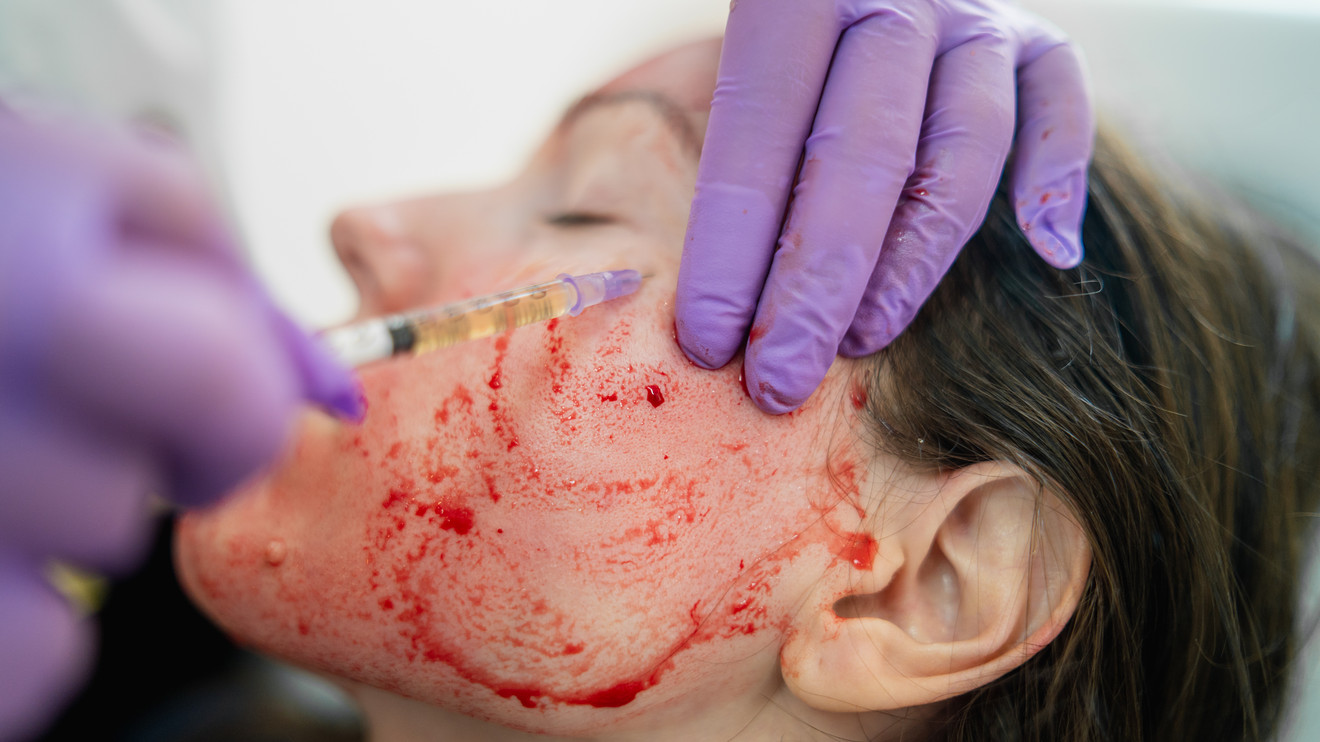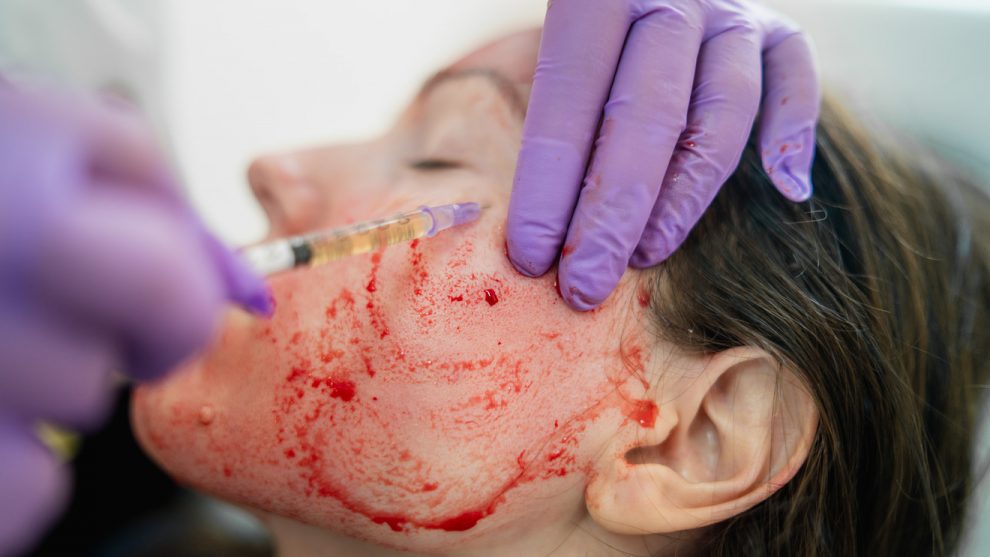
Some of the most buzzworthy beauty treatments come with some ugly — and sometimes life-threatening — side effects.
The New Mexico Department of Health is “strongly” encouraging anyone who received any injection-related procedures at the now-closed VIP Spa in Albuquerque between May and September 2018 to come in for free and confidential HIV and hepatitis B and C testing, it announced this week. The warning comes after two clients of the now-shuttered spa tested positive for HIV last fall, which the health department believes they contracted from getting “vampire facials” at the clinic.
“While over 100 VIP Spa clients have already been tested, NMDOH is reaching out to ensure that testing and counseling services are available for individuals who received injection related services at the VIP Spa,” said Kathy Kunkel, the NMDOH cabinet secretary, in a statement. “Testing is important for everyone as there are effective treatments for HIV and many hepatitis infections.” The VIP Spa closed last September.
See: Young people’s blood will not make you live forever, FDA warns
The controversial “vampire facial” trademarked by the Cellular Medicine Association, also known as the platelet-rich plasma (PRP) facial popularized by celebrities such as Kim Kardashian, involves drawing a person’s blood, separating the platelets, and then spreading the platelet-rich plasma (which has been combined with cosmetic fillers like Restylane or Juvederm) on the face, which has been punctured with micro-needles, for $1,500 to $2,500. It’s supposed to stimulate collagen production to create new skin and remove fine lines so that you look younger. But if done improperly, it can lead to infection.
The Cellular Medicine Association responded to the New Mexico spa’s HIV cases by claiming that the clinic employed unlicensed technicians who were not trained properly, and it illegally used the brand’s “vampire facial” name. It added in a statement on its site that: “Qualified medical professionals handle blood all day long without serious problems (in emergency rooms, in operating rooms, and in offices) and this procedure is even safer since it’s done with the patient’s own blood. Done properly, FDA-approved devices are used and nothing in the room with one patient has on it even the possibility of one drop of blood from any previously treated patient.” But it admitted that, “done improperly — people can be killed by cross-contamination.”
The Albuquerque infections are a reminder that at least 50% of medical spas and medical aesthetic practices operate illegally, according to the American Med Spa Association. And while these med spas are required to have doctors serve as their medical directors, not every state requires that those medical professionals be on site. That means the technician in the white coat injecting fillers into your skin or using a laser to remove your body hair may have been trained in those treatments, but they might not be doctors or nurses. So they may not be schooled in what to do if a medical emergency or side effect comes up during your treatment. Check out your rules by state here.
See: One in four people is considering plastic surgery to look younger at work
Despite the risks, the American Med Spa Association reports that there are 4,200 med spas across the country in the $3.97 billion industry, which has doubled in the past five years, and is expected to double again by 2020. And as 36% of U.S. adults in a recent Harris Poll admitted they would consider cosmetic treatment, it can be tempting to buy into some potentially risky procedures. These four treatments (as well as the vampire facial) should give you pause. (And before getting any kind of work done, see a doctor to confirm you are a good candidate for the procedure, and to discuss possible side effects. And make sure that your procedure is being done by a certified physician.)
See: 10 things medical spas won’t tell you
Brazilian Butt Lift
The most deadly cosmetic procedure kills as many as one in 3,000 patients, warned a recent task force of international board-certified plastic surgeon societies, including the American Society of Plastic Surgeons. Brazilian butt lifts ( BBLs) combine liposuction (sucking fat from a place in the body where the patient doesn’t want it) and fat grafting (injecting the fat into the rear end to create a fuller derriere). And the task force suggested that more non-board-certified and non-plastic surgeons are performing the challenging surgery as demand has swelled; about 20,300 buttock augmentation procedures using fat grafting were performed in 2017, which more than doubled in the last five years. In January, a Bronx woman was charged with manslaughter after illegally and lethally injecting a patient in the rear with silicone to enhance her backside. Hip-hop star Cardi B told GQ last year that she pumped up her posterior with fillers from a Queens basement clinic for $800, which “was the craziest pain ever” and leaked for five days.
See: America’s fastest-growing plastic surgery procedure takes place below the belt
Radon Spas
While the Environmental Protection Agency estimates that approximately 20,000 Americans die of radon-related lung cancer each year just from the radon buildup in basements and in their homes, some people are flocking to “radon health mines” and “radon spas” in Montana, the Ukraine and Germany, ScienceAlert.com reported. Inhaling air tainted with radon in decommissioned gold and uranium mines, or even drinking radon water, is believed to treat chronic pain like fibromyalgia, arthritis and back pain. But while a few scientific research papers suggest radon therapy may treat pain better than a placebo, more research has clearly linked high concentrations of radon with lung cancer.
Fish Pedicures
This treatment calls for inserting your feet into water filled with small garra rufa fish — aka “doctor fish” — that nibble away the rough, dead skin on your feet. But a toe-curling cautionary tale reported in JAMA Dermatology last year revealed a New York woman in her 20s lost all of her toenails after getting a fish pedicure. The patient developed split toenails, known medically as onychomadesis. She had no family history of nail disorders, and no other medical problems, so Dr. Shari Lipner, a dermatologist at Weill Cornell Medicine in New York, deduced the most likely conclusion was the fish pedicure the woman had a few months before. “Most likely it’s from the trauma of the fish on the nail matrix, which is the nail growth center, that probably caused this condition,” she told the “Today” show, adding that she “would never” recommend that her patients get this fishy procedure done. Indeed, fish pedicures are banned in several states, including Texas, Florida and Massachusetts, because it’s impossible to fully sanitize either the living fish or the water they work in.
Cryotherapy
Whole body cryotherapy [WBC] calls for spending two to four minutes in a chamber or small room blasted by liquid nitrogen so that the temperature plummets to at or below -200 degrees Fahrenheit, which is suppose to relieve pain and boost muscle recovery after exercise, as well as tighten skin and reduce wrinkles. But the FDA has taken a chilly stance on the trend, offering a consumer update in 2016 that “despite claims by many spas and wellness centers to the contrary, the U.S. Food and Drug Administration (FDA) does not have evidence that WBC effectively treats diseases or conditions like Alzheimer’s, fibromyalgia, migraines, rheumatoid arthritis, multiple sclerosis, stress, anxiety or chronic pain.” It added that the FDA has not cleared or approved any WBC devices for medical treatment of any specific medical conditions. What’s more, the American Academy of Dermatology warns that the extreme cold can cause skin injuries such as frostbite, frozen limbs and rashes. Indeed, American sprinter and 2004 Olympic champion Justin Gatlin developed frostbite on both feet during a WBC session, ESPN reported. And researchers in Finland reported that 16% of participants in a WBC study developed mild frostbite.






